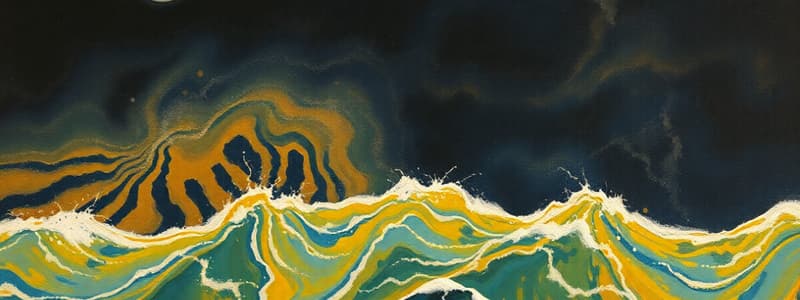Podcast
Questions and Answers
What is the study of earth's rocks and its composition called?
What is the study of earth's rocks and its composition called?
- Astronomy
- Meteorology
- Oceanography
- Geology (correct)
Which branch of Earth Science studies weather and climate?
Which branch of Earth Science studies weather and climate?
- Meteorology (correct)
- Geology
- Oceanography
- Astronomy
What does the Richter Scale measure?
What does the Richter Scale measure?
Energy of earthquakes
The Pacific Ring of Fire experiences 90% of the world's seismic activity.
The Pacific Ring of Fire experiences 90% of the world's seismic activity.
What are surface waves?
What are surface waves?
Seismic waves are energy released by an ______.
Seismic waves are energy released by an ______.
What is the focus of an earthquake?
What is the focus of an earthquake?
How many major tectonic plates are there?
How many major tectonic plates are there?
Which of the following is an example of a minor tectonic plate?
Which of the following is an example of a minor tectonic plate?
Match the following seismic terms with their definitions:
Match the following seismic terms with their definitions:
Flashcards are hidden until you start studying
Study Notes
Earth Science Overview
- Earth science focuses on the study of the Earth and its components, encompassing various branches such as geology, meteorology, oceanography, and astronomy.
- Seismic waves are classified into different types based on their movement and speed, including faster-than-surface waves and shear waves.
Major Branches of Earth Science
- Geology: Examines Earth's rocks and composition; utilizes measurements written in Hindu-Arabic.
- Meteorology: Studies weather patterns and climate; employs scales like the Richter Scale to measure energy from seismic waves.
- Oceanography: Investigates oceans and water bodies; provides insights into marine and aquatic systems.
- Astronomy: Focuses on space and celestial bodies; often employs Roman numerals for measurements.
Earth Structure and Mechanics
- The lithosphere includes the Earth's crust and upper mantle, characterized as rigid and brittle; it is responsible for tectonic activities.
- Lithospheric plates float atop the mantle, moving and interacting along plate boundaries to create earthquakes.
Earthquake Fundamentals
- An earthquake is the vibration of the Earth's crust caused by the rapid release of seismic energy, marking a significant geologic event.
- The focus refers to the earthquake's origin beneath the Earth's surface, while the epicenter is directly above this point on the surface.
Seismic Wave Properties
- Surface waves are the slowest seismic waves, moving through the Earth's crust with most destructive potential.
- Love waves, faster than surface waves, exhibit horizontal, side-to-side movements, creating considerable damage.
Measuring Earthquakes
- Magnitude measures the energy released during an earthquake, primarily using the Richter Scale developed by Charles Richter.
- Intensity assesses the strength of shaking, often measured using the Modified Mercalli Intensity Scale.
- Seismographs are instruments used to detect and record seismic waves, producing seismograms that detail the earthquake's characteristics.
- The triangulation method helps to locate an earthquake's epicenter by analyzing data from three seismic recording stations.
Tectonic Plates
- Major tectonic plates include Pacific, North American, Eurasian, African, Antarctic, Australian, and South American.
- Minor tectonic plates consist of Nazca, Arabian, Caribbean, Cocos, Juan de Fuca, Scotia, and Philippine Sea plates.
- Micro plates cover areas less than 1 million square kilometers.
- The Philippine Mobile Plate interacts with both the Eurasian and Philippine Sea plates, representing a complex tectonic region.
Faults and Fractures
- A fault is a fracture zone between two blocks of rock where earthquakes often occur; faults without historical activity are considered inactive.
- Fractures are cracks in rocks that can impact seismic activity and integrity.
Volcanoes and Seismicity
- The Philippine Institute of Volcanology and Seismology (PHIVOLCS) monitors volcanic, earthquake, and tsunami activities in the Philippines.
- The Pacific Ring of Fire is a zone with a high incidence of earthquakes and volcanic eruptions, accounting for a significant percentage of global seismic activity.
Studying That Suits You
Use AI to generate personalized quizzes and flashcards to suit your learning preferences.




